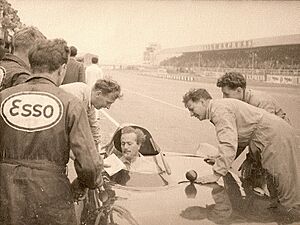Colin Chapman facts for kids
Quick facts for kids
Colin Chapman
|
|
|---|---|
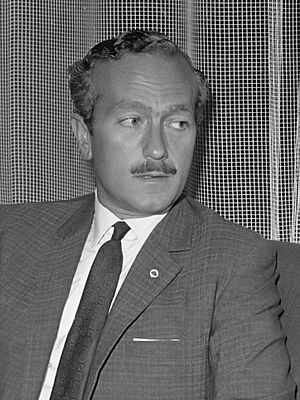
Chapman in 1965
|
|
| Born | 19 May 1928 |
| Died | 16 December 1982 (aged 54) |
| Formula One World Championship career | |
| Active years | 1956 |
| Teams | Vanwall |
| Entries | 1 (0 starts) |
| Championships | 0 |
| Wins | 0 |
| Podiums | 0 |
| Career points | 0 |
| Pole positions | 0 |
| Fastest laps | 0 |
| First entry | 1956 French Grand Prix |
| Last entry | 1956 French Grand Prix |
Anthony Colin Bruce Chapman (born May 19, 1928 – died December 16, 1982) was a brilliant English engineer and inventor. He was famous for creating the sports car company Lotus Cars.
Colin Chapman started Lotus in 1952. He worked on it in his free time with help from friends. He used his knowledge of airplane design to make cars better. Chapman believed cars should be light and handle well, rather than just having a lot of engine power. He famously said, "Adding power makes you faster on the straights. Subtracting weight makes you faster everywhere."
Under his leadership, Team Lotus won many big races. They won seven Formula One team titles and six driver championships. They also won the Indianapolis 500 race in the United States. This was between 1962 and 1978. Lotus Cars also built many popular sports cars for everyday people. Lotus is one of the few English car makers still around today. Colin Chapman sadly passed away from a heart attack in 1982, when he was 54 years old.
Contents
Early Life and Education
Colin Chapman was born on May 19, 1928, in London, England. His father ran a hotel near Hornsey Railway Station. Colin went to Stationers' Company's School.
He later studied structural engineering at University College London. While there, he joined the University of London Air Squadron and learned to fly planes. He briefly joined the Royal Air Force in 1948. After leaving the RAF, he worked for a company called British Aluminium. He used his engineering skills to try and sell aluminum for building structures.
Building a Racing Legacy
In 1948, Chapman built his first car, the Lotus Mk1. It was a changed Austin 7 car. He raced it in local events. He named his car "Lotus," but he never said why. One idea is that it was named after his girlfriend, Hazel, whom he called "Lotus blossom." With the money he won, he built the Lotus Mk2.
Chapman was very good at finding ways to make his cars faster. He always followed the rules. He sold kits of his successful cars, like the Lotus 6. More than 100 kits were sold by 1956. Things really took off with the Lotus Seven in 1957. Even today, another company, Caterham Cars, still makes a version of that car.
In the 1950s, Chapman moved up through different levels of motor racing. He designed and built many racing cars. They were so good that people wanted to buy them. Eventually, he reached Formula One, the top level of racing. In 1956, he even drove a Vanwall F1 car himself. But he crashed during practice for the 1956 French Grand Prix. After that, he decided to focus only on designing cars.
Colin Chapman, along with John Cooper, changed motor sport forever. Their small, lightweight cars had their engines in the middle. This made them handle much better. Even though they had less power, their cars often beat the bigger, front-engined cars from teams like Ferrari.
With driver Jim Clark, Team Lotus became almost unbeatable. Clark drove the Lotus 25 to win Team Lotus's first F1 World Championship in 1963. In 1965, Clark also won the Indianapolis 500 in a Lotus 38. It was the first time a car with a mid-engine won that race. Clark and Chapman became very close friends. Jim Clark's death in 1968 deeply saddened Chapman.
Many important people in racing worked for Lotus. These included Cosworth founders Mike Costin and Keith Duckworth. Even famous driver Graham Hill worked as a mechanic at Lotus. In 1966, Chapman convinced the Ford Motor Company to help pay for the development of the famous Cosworth DFV race engine.
Amazing Car Innovations
Many of Colin Chapman's ideas are still used in Formula One today. He was one of the first to use struts for the rear suspension of cars. These are now known as Chapman struts.
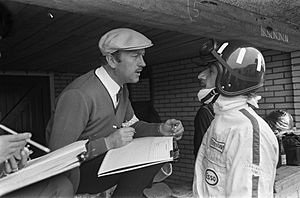
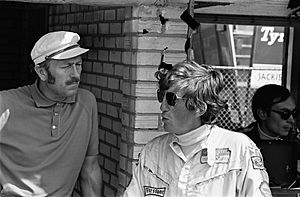
Chapman's next big idea was using a monocoque chassis for racing cars. This was first seen in the amazing 1962 Lotus 25 Formula One car. A monocoque chassis means the car's body is also its main structure. This made cars lighter and stronger. It also made them safer for drivers in a crash. The first car to use this was the 1922 Lancia Lambda. Lotus had already used this idea in their 1958 Lotus Elite road car. That car's body was made of fibreglass, a composite material.
After seeing the Lotus 25, American driver Dan Gurney invited Chapman to the 1962 Indianapolis 500. Chapman then suggested to Ford Motor Company that they build an aluminum monocoque car for Indianapolis. Ford agreed. The Lotus 29 raced at Indianapolis in 1963, with Jim Clark finishing second. This design quickly replaced older tube-frame chassis. Today, top racing cars still use this idea, though they now use carbon fibre instead of aluminum.
Chapman also helped bring aerodynamics into Formula One car design. This means using air flow to help the car. Lotus was one of the first to add wings to cars in 1968. These wings created "downforce," pushing the car onto the road. This helped cars go faster around corners. Early wings were high up, but they often broke. So, the FIA made rules to attach them directly to the car's main body. Chapman also moved the car's radiators from the front to the sides. This made the car more streamlined and balanced its weight better. These ideas are still used in almost all high-performance racing cars today.
Working with Tony Rudd and Peter Wright, Chapman also invented "ground effect" for Formula One. This created a low-pressure area under the car. It was like a vacuum, sucking the car to the road. This gave the car huge grip when cornering. Early designs used "skirts" that touched the ground to seal this low-pressure area.
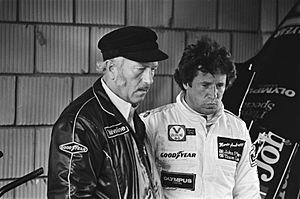
Chapman then designed a car that used only ground effect for downforce. This meant it didn't need wings, which caused drag and slowed the car down. His best car using this idea was the Lotus 79. It completely dominated the 1978 championship. However, the skirts were later banned because they could get damaged. If a skirt broke, the car would lose downforce and become unstable. The FIA changed rules to reduce ground effect in 1981 and banned it in 1983. But car designers have found other ways to get some of that downforce back.
One of his last big ideas was a dual-chassis Formula One car, the Lotus 88 in 1981. To make ground effect work best, the car's parts needed to be very stiff. But this made the ride very bumpy for the driver. So, Chapman made a car with two chassis. One chassis, where the driver sat, was soft. The other chassis, which held the ground effect parts, was stiff. The car passed checks at some races, but other teams complained. It was never allowed to race.
Chapman was also a smart businessman. He brought major advertising sponsorship into auto racing. This changed Formula One from a hobby for rich people into a huge, high-tech business. He was one of the first to put non-car product ads on his cars. Famous examples include cigarette brands like Gold Leaf and John Player Special.
Later Life and Passing
The night before he passed away, Colin Chapman watched a performance by his friend and Lotus customer, Chris Barber, a famous jazz musician. On December 16, 1982, Team Lotus was testing their first Formula One car with active suspension. This technology later appeared in the Lotus 99T in 1987. On that same day, Colin Chapman had a fatal heart attack at his home in Norwich. He was 54 years old.
Family
Colin Chapman was married to Hazel Chapman (1927–2021). They had two daughters and one son.
Awards and Recognition
- He received "Mike's Mug" from the Royal Aero Club in 1961.
- He was named The Guardian 'Young Businessman of the Year' in 1970.
- He was made a Commander of the Order of the British Empire (CBE) in 1970 for his work in exports.
- He was added to the International Motorsports Hall of Fame in 1994.
- He was added to the Motorsports Hall of Fame of America in 1997.
Images for kids
-
Chapman with Jochen Rindt at the 1970 Dutch Grand Prix.
See also
 In Spanish: Colin Chapman para niños
In Spanish: Colin Chapman para niños


